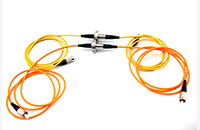Fiber optic slip rings and high frequency slip rings are products with unique functions and relatively small size among slip rings. These two types of slip rings can be installed separately in electromechanical systems, but in most cases they are integrated in other volumes. Used in larger slip rings. For example, optical fiber slip rings are often integrated with hat-type, hollow shaft and high-current slip rings. In the process of developing these integrated slip rings, Aminite Electronics discovered a rule, that is, the market demand for single-channel integrated products is compared. For this reason, Aminite has developed a series of combined slip rings that integrate single-channel optical fiber slip rings and high-frequency slip rings.

Fiber optic slip rings
Whether it is Aminite photoelectric integrated slip ring or electric high frequency integrated slip ring, it is developed based on the AminiteLPC-12/24/30/36T series cap type slip ring with through hole. This cap type slip ring Designed with 3~7mm center vias, there are 12, 24, 30, and 36 channels with 4 different channels to choose from. The designed rated current is 2A per channel, and it supports mixed transmission of electrical signals. Aminite designers cleverly used the through-hole space of the slip ring to install Aminite single-channel LPCC series high-frequency slip rings or some models of single-channel optical fiber slip rings.
In order to distinguish it from other standard products, Aminite Electronics named the product with integrated high-frequency slip ring LPC-1C, and the series of products with integrated optical fiber slip ring named LPC-1F. First look at the AminiteLPC-1C series. Thanks to its integrated LPCC series of high-frequency slip rings, this series of products not only have strong power transmission capabilities, but also can realize the transmission of single-channel high-definition video and other signals. After the coaxial cable used is replaced with a 50Ω impedance model, it can also be used to transmit radio frequency signals.
LPC-1F series photoelectric integrated slip ring can be regarded as a product after replacing LPCC high frequency slip ring. After replacing high frequency slip ring with optical fiber slip ring, especially after using multimode optical fiber slip ring, its signal transmission ability will be improved. The rapid growth is due to the inherent large bandwidth and high-speed transmission characteristics of light transmission. Of course, the multi-mode optical fiber slip ring also has a shortcoming, that is, the transmission distance is not far enough. If you want to pursue a longer optical signal transmission distance, you can replace the multi-mode optical fiber slip ring with a single-mode product.
The AminiteLPC-1C and LPC-1F series of integrated standard slip rings can be applied in many fields and even overlap. For example, Aminite has provided these two solutions for monitoring equipment of different customers. In addition to the monitoring field, these two types of slip rings can also be used as rotating transmission solutions for radio frequency electronics, automatic machinery and other industries. Compared with other photoelectric and electric high-frequency customized products, this series of integrated slip rings undoubtedly provide customers with a more cost-effective solution for the integrated transmission of photoelectric signals. In addition, the cap slip ring, fiber optic slip ring and high frequency slip ring used in this series of integrated products are all Aminite’s standard slip rings. This has the advantage that these slip ring parts are fully stocked and can be scheduled and delivered at any time The cycle is very short.

